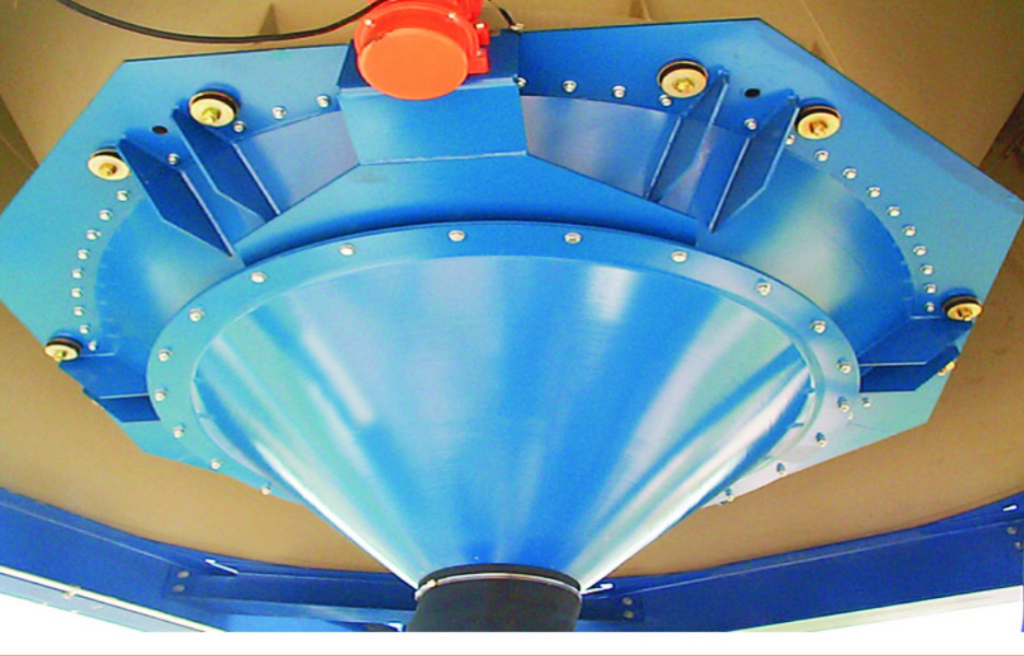Powder materials are widely used in various industries, such as food, chemical, pharmaceutical, mining, construction, agriculture, etc. However, handling and storing powder materials can be challenging, as they tend to form bridges, arches, or ratholes in silos or hoppers, preventing a smooth and consistent discharge. This can cause problems such as material degradation, segregation, contamination, loss of storage capacity, energy waste, and production downtime.
One of the most effective solutions to overcome these problems is to use bin activators. Bin activators are devices that attach to the bottom of silos or hoppers and create vibrations to fluidize the powder materials and facilitate their flow. Bin activators can improve the flow of powder materials by reducing the friction and cohesion between the particles, breaking down any potential arches or bridges, and promoting mass flow.
In this blog post, we will explain the benefits and applications of bin activators, as well as their design and operation principles.
Benefits of Bin Activators
Bin activators offer several advantages over other methods of powder material discharge, such as pneumatic hammers, air cannons, or fluidized pads. Some of these advantages are:
- They provide a uniform and controlled flow of powder materials, regardless of their properties or the geometry of the silo or hopper.
- They prevent the powder materials from degrading, segregating, or contaminating, as they do not subject them to excessive force or air injection.
- They increase the storage capacity of the silo or hopper, as they prevent the powder materials from compacting or bridging in the upper part of the structure.
- They reduce the energy consumption and maintenance costs, as they operate with a low power motor and have no moving parts or consumables.
Applications of Bin Activators
Bin activators can be used for a wide range of powder materials, such as flour, sugar, salt, cement, sand, coal, plastic pellets, animal feed, etc. They can be applied in various industries, such as food, chemical, pharmaceutical, mining, construction, agriculture, etc. They can also be customized to suit different sizes, shapes, and configurations of silos or hoppers, as well as different environmental conditions, such as temperature, humidity, pressure, etc.
Design and Operation of Bin Activators
Bin activators consist of three main components: the cone, the seal, and the vibrator. The cone is the conical-shaped part that is attached to the bottom of the silo or hopper. The cone has a baffle plate at its center, which helps to direct the powder material flow and impart force to the material to break down any potential arches or bridges. The cone also has a secondary deflector plate below the baffle, which acts as a wedge to relieve the weight of the material from the lower part of the cone and push it around the areas near the cone surface.
The seal is the flexible connection between the cone and the silo or hopper. The seal is made of an engineered polymer that prevents the material from leaking and the cone from slipping off. The seal also isolates the vibrations from the silo or hopper, so that only the cone vibrates and not the entire structure.
The vibrator is the motor that generates the vibrations for the cone. The vibrator is housed in a single sealed enclosure, with no belts or oil to cause maintenance issues or contamination. The vibrator has adjustable eccentric weights that allow the vibration intensity and frequency to be changed according to the material characteristics and flow requirements.
The operation of bin activators is based on the principle of gravity and vibration. When the material comes in contact with the cone, it compresses and compacts the material before discharging it. The cone vibrates horizontally and vertically, creating a fluidized zone of material around the cone. The vibration also transmits force to the material in the upper part of the silo or hopper, as the movement propagates from particle to particle. As a result, all the particles flow freely in the bin activator towards its outlet. As long as there is no obstruction in the outlet, the material will be discharged from the bin activator.
The outlet of the bin activator is designed to be large enough to allow the material to flow without restriction. The outlet can be connected to various downstream equipment, such as screw conveyors, belt conveyors, pneumatic conveyors, etc. The bin activator can also be equipped with a slide gate valve or a butterfly valve to control the flow rate and stop the flow when needed.
Conclusion
Bin activators are effective and efficient devices that enable the smooth and reliable discharge of powder materials from silos or hoppers. They are designed to create a fluidized zone of material around a vibrating cone, which facilitates the material flow and prevents problems such as bridging, arching, or ratholing. They offer several advantages over other methods of material discharge, such as lower energy consumption, higher storage capacity, and better material quality. They can be used for a variety of materials and industries, and can be adapted to different requirements and specifications.
If you are interested in learning more about bin activators, you can visit the websites of some of the leading bin activator manufacturers and suppliers, such as Polimak, Spiroflow, Palamatic Process, etc. You can also contact them for more information or a quote for your specific needs.



